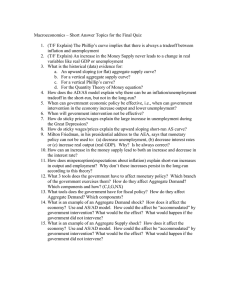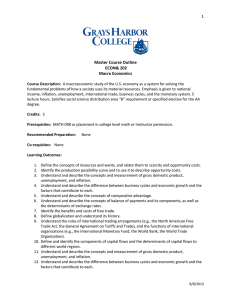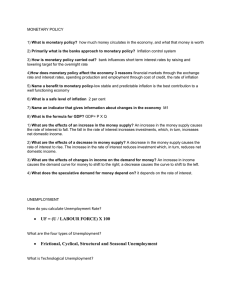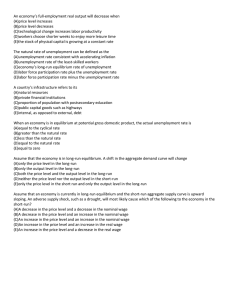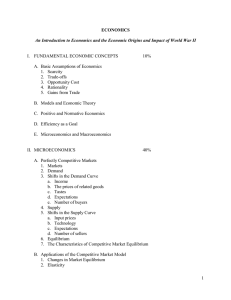1. three
advertisement
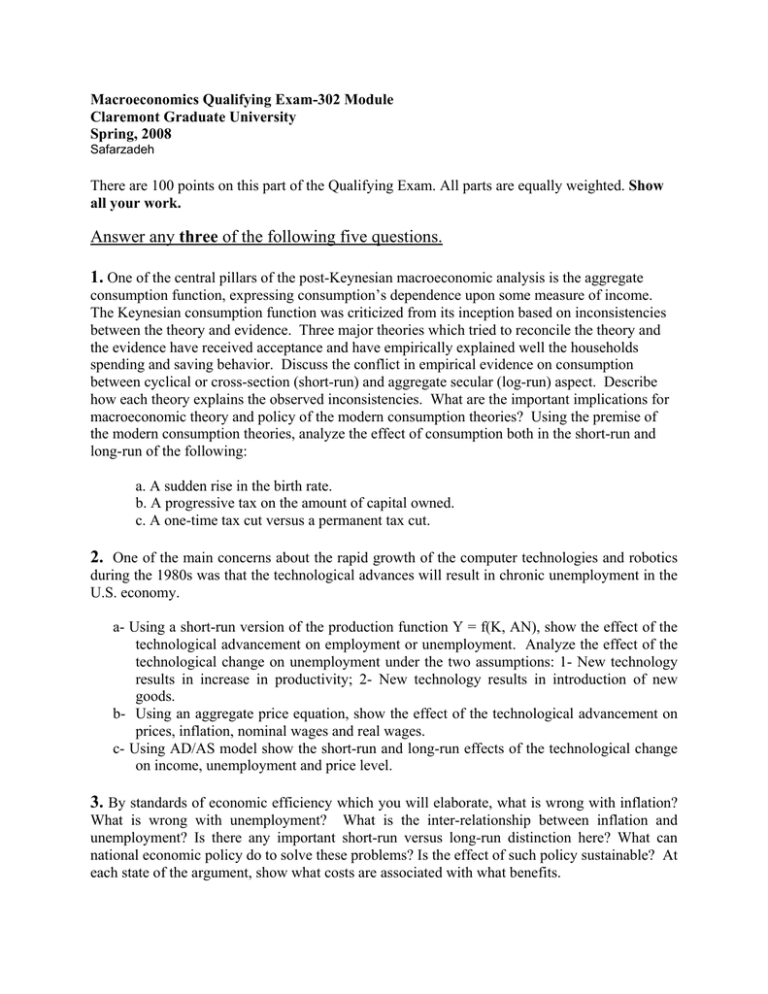
Macroeconomics Qualifying Exam-302 Module Claremont Graduate University Spring, 2008 Safarzadeh There are 100 points on this part of the Qualifying Exam. All parts are equally weighted. Show all your work. Answer any three of the following five questions. 1. One of the central pillars of the post-Keynesian macroeconomic analysis is the aggregate consumption function, expressing consumption’s dependence upon some measure of income. The Keynesian consumption function was criticized from its inception based on inconsistencies between the theory and evidence. Three major theories which tried to reconcile the theory and the evidence have received acceptance and have empirically explained well the households spending and saving behavior. Discuss the conflict in empirical evidence on consumption between cyclical or cross-section (short-run) and aggregate secular (log-run) aspect. Describe how each theory explains the observed inconsistencies. What are the important implications for macroeconomic theory and policy of the modern consumption theories? Using the premise of the modern consumption theories, analyze the effect of consumption both in the short-run and long-run of the following: a. A sudden rise in the birth rate. b. A progressive tax on the amount of capital owned. c. A one-time tax cut versus a permanent tax cut. 2. One of the main concerns about the rapid growth of the computer technologies and robotics during the 1980s was that the technological advances will result in chronic unemployment in the U.S. economy. a- Using a short-run version of the production function Y = f(K, AN), show the effect of the technological advancement on employment or unemployment. Analyze the effect of the technological change on unemployment under the two assumptions: 1- New technology results in increase in productivity; 2- New technology results in introduction of new goods. b- Using an aggregate price equation, show the effect of the technological advancement on prices, inflation, nominal wages and real wages. c- Using AD/AS model show the short-run and long-run effects of the technological change on income, unemployment and price level. 3. By standards of economic efficiency which you will elaborate, what is wrong with inflation? What is wrong with unemployment? What is the inter-relationship between inflation and unemployment? Is there any important short-run versus long-run distinction here? What can national economic policy do to solve these problems? Is the effect of such policy sustainable? At each state of the argument, show what costs are associated with what benefits. 4. To stop the economy from sliding to recession, the Fed has resorted to expansionary monetary policy, lowering the Federal Funds rate to 2% and increasing liquidity. The government, on the other hand, has followed by expediting the tax cut and mailing the rebates early. Take the text book Keynesian IS - LM model and analyze the effectiveness of these policies separately and together under the following assumptions: a.-Assume that individuals have a myopic view of the economy and do not consider the effects of the policy change on future macro variables. b.-Assume that individuals consider the long run effects of changes in future macro variables when forming expectations of future output and future interest rates (foresighted economic agents). 5. A simple macro-model of the economy is expressed by the following equilibrium conditions in three markets: Goods Market: Money Market: Labor market: Y = c(Y – tY) + I(r) + G M/P = l(r) + k(Y) Pf(N) = Peg(N) The Production technology of the economy is given by the aggregate production function, Y = F(N, K). It is assumed that economic agents form their expectations of the future prices by using the current and the past prices as expressed by expectations model Pe = P(P). Answer the following questions given the information above. a. Analyze the effectiveness of the monetary policy given the system of equations above and the assumed expectations model. Make a clear distinction between extreme Keynesian and extreme Classical. What is the effect of monetary policy if economic agents’ expectations are based on adaptive expectation? b. Now, assume that economic agents form their execrations of the future prices based on the rational expectations model, Pt = t-1Pt + et , with t-1e t = 0. Derive an expression for AD and AS using the equilibrium models given above. Analyze and discuss the effectiveness of the monetary policy using the rational expectations hypothesis. How does your conclusions here differ from the conclusions derived in part a?
